World
About Andrew Cusack
 Writer, web designer, etc.; born in New York; educated in Argentina, Scotland, and South Africa; now based in London.
Writer, web designer, etc.; born in New York; educated in Argentina, Scotland, and South Africa; now based in London. read more
News
Blogs
Reviews & Periodicals
Arts & Design
World
France
Mitteleuropa
Knickerbockers
Argentina
The Levant
Africa
Cape of Good Hope
Netherlands
Scandinavia
Québec
India
Muscovy
Germany
Academica
Cape Dutch California
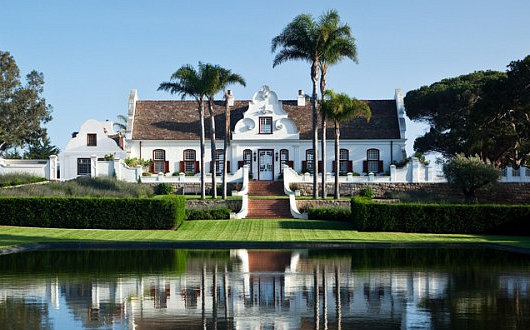
While this Cape Dutch mansion sits in the hills of Montecito in California, it bears the name (and style) of an old Cape Peninsula town. “Constantia” was designed by Ambrose Cramer (take a peek at his nifty grave) in 1929 for Arthur & Grace Meeker, with landscaping by Lockwood deForest, Jr. The Meekers sold the house to the architect Jack Warner. In the late 1960s, Stewart & Katherine Abercrombie bought the place, and hosted the Dalai Lama on one of his trips to the United States. It was the subject of a 1979 feature in Architectural Digest. The place is for sale, currently listed at $17,900,000. (more…)
“Lourdes”
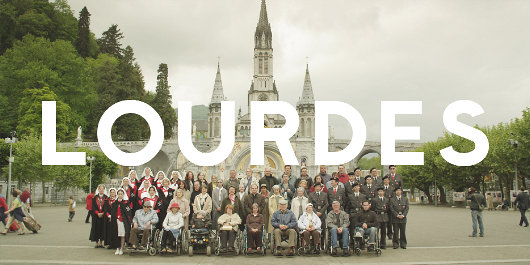
Various sources have brought to light the new film “Lourdes” by the Austrian director Jessica Hausner. The film depicts the pilgrimage to Lourdes of a non-particularly religious woman (played by Sylvie Testud) suffering from Mutiple Sclerosis who is healed of her illness. The film by a non-believing director has met with both praise and suspicion from Catholic quarters, and has been compared, at least stylistically, to the work of Michael Haneke (whose latest, “The White Ribbon” is currently showing in New York). Latest to weigh in is the Catholic Herald‘s indispensable Anna Arco, who writes:
I saw it as an exercise in theodicy where God loses. In a quiet dispassionate way, Jessica Hausner, the film’s Austrian director, paints a bleak picture of a world where fate is a blind, arbitrary force and human beings clutch at the straws of faith, half-truths in their cowardly despair. The suffering are not healed, human nature is selfish and the problem of pain is not solved. God can’t exist because he isn’t fair. Christianity offers a web of half-truths obscuring a nihilistic reality.
Miss Arco recently spoke with the director, and the interview will be published in the next Catholic Herald. (more…)
BA: “an old-fashioned European city”
“Argentina has to be one of the most underrated travel destinations,” Michael Buerk writes in his salute to Argentina in today’s Daily Telegraph. An excerpt:
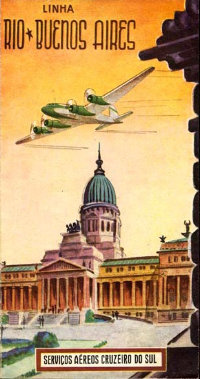 AT THE HEART OF IT ALL IS Buenos Aires, one of the world’s most exciting cities. I was there for months during the Falklands War, reporting for the BBC. They were praying for me in our local church. If only they had known how close I had come to eating myself to death – those steaks are huge – they would have prayed even harder.
AT THE HEART OF IT ALL IS Buenos Aires, one of the world’s most exciting cities. I was there for months during the Falklands War, reporting for the BBC. They were praying for me in our local church. If only they had known how close I had come to eating myself to death – those steaks are huge – they would have prayed even harder.
It is an intensely Anglophile country, and was even then. The upper crust didn’t want to argue about the sovereignty of the Falklands (any more than they would want to argue now about oil drilling); they wanted to know where in Jermyn Street to order their cavalry twills. The hundreds of thousands of descamisados (literally, “shirtless ones”) who packed the Plaza de Mayo screaming for Mrs Thatcher’s blood would break off when they saw the BBC logo on the camera to make sure they had got the lyrics to “Hard Day’s Night” exactly right. The city’s biggest department store was called Harrods, the poshest club was (and is) the Hurlingham and the most popular film during the war was “Chariots of Fire”.
The veterans of the Malvinas, portly and grey-haired now, camp out in the Plaza de Mayo, still begging for better pensions. Porteños (the locals’ name for themselves) call them “the whiners”. The memorial to the 700 or so Argentine dead is prominent enough, but it is just a list of names and the eternal flame has long since gone out. It faces the great clock, built by the British a century ago (with a movement copied from Big Ben). The locals still call it the English Tower, even though it was officially renamed after the conflict. The cause still rankles, but the war is an embarrassment.
There’s poverty in the suburbs but, at its heart, Buenos Aires is a grand city, laid out in the days when its wealth and its future seemed unlimited. The world’s widest avenues, finest opera house, most opulent fin de siècle town houses, and – my idea of heaven – Italian restaurants cooking the world’s most wonderful meat. (Try La Brigada, where they cut the tenderloin with spoons. And don’t order “Baby Beef” looking for a light meal; it weighs in at just short of a kilo.)
It’s an old-fashioned European city, with a café society oddly short of dark faces. The original natives, and the African slaves, were wiped out or pushed out. The most prominent of the country’s remaining blacks (70 or so, it is said) was arrested at the airport recently because officials thought her Argentine passport must be a forgery.
The city is full of grand monuments, mostly to the chancers who snatched independence when Spain had its back turned, bowing the knee to Napoleon. They are as extravagantly memorialised in death as they were spurned in life; nearly all of them died in exile.
Argentina’s real heroes can be seen, stuffed, in the colourful old dock area, La Boca. Life-size models stare at you from the shops and down from the balconies. There are just three of them, and a tawdry trio they are. Eva Duarte Peron, of course, the actress who slept her way to the bottom of the movie business and into the life of a crypto-fascist colonel on the make; a long-dead tango warbler called Carlos Gardel; and Maradona, the squat footballer with the hand of God and the soul corroded by cocaine. Two of them died young; the third is still trying.
Death is a big thing in Argentina. La Recoleta cemetery is worth the trip in itself. It’s an entire suburb of gloriously overblown mausolea; a gentleman’s club for the dead, even harder to get into than the Garrick. Evita is there, in the Duarte family tomb. Her father’s relatives famously said they wouldn’t be seen dead with her; now she’s banged up with them for all eternity. There’s a new museum to Evita that’s worth seeing, with a pinch of salt.
I would dispute Bs.As. being “an old-fashioned European city”. It is instead a rather vigorous American city that retains many of the best attributes of an old-fashioned European city.
Mimi Coertse: “Der Hölle Rache” van Die Zauberflöte
Van al die operahuise in Afrika, die helfte is in Suid-Afrika — dink jy, daar is net vier operahuise in die vasteland. Nietemin, opera het ’n ryk en vrugbaar tradisie in die land, en die koningin van Suid-Afrikaanse opera-sangers is die sopraan Mimi Coertse. Sy was in Durban gebore in 1932 en het haar stem-opleiding in Suid-Afrika voltooi. In 1953, Coertse het die uitsaaier en komponis Dawid Engela getroud. (Engela het sy “Huwelikskantate” vir hul troue saamgestel). In Januarie 1955, Coertse het haar opera debuut gemaak in ’n kleine rol in Parsifal by die Teatro San Carlo in Napels.
Dit was 17de Maart 1956 — St. Patrick’s Day — toe Coertse die rol van die Koningin van die nag gesing in “Die Zauberflöte” met die Weense Staatsopera in Oostenryk. Sy het met die Weense Staatsopera vir meer as twintig jare gebly. Gravin Christl Schönfeld onthou:
In sy lang voortgang, Mimi Coertse het baie eerbewyse opgestapel. In 1961, die Medalje van Eer van Die Suid-Afrikaanse Akademie vir Wetenskap en Kuns; in 1966, die prestige titel van “Kammersängerin” vanaf die regering van Oostenryk; in 1985, die Suid-Afrikaanse Dekorasie vir Voortreflike Diens; en in 1996, die “Oesterreichische Ehrenkreuz für Wissenschaft und Kunst” (Oostenrykse Erekruis vir Wetenskap en Kuns) — die hoogste kunsdekorasie van Oostenryk.
Waar is sy nou? Sedert 1998, Mimi Coertse bestuur die “Black Tie Ensemble” — ’n projek om die verandering tussen opleiding en professionele uitvoering te versag. ’n Halfeeu van diens in die kunste voortsit!
A Seraphic Book Launch in Toronto
Torontonians or those in the general vicinity of that metropolis might be interested in attending the upcoming launch of Seraphic‘s new book, Seraphic Singles: How I Learned to Stop Worrying and Love the Single Life. Of course, Dorothy is no longer single but instead happily married to a Scottish friend of mine, and you can see her gleefully prancing about the grounds of the Historical House the happy couple now call their home in this 4m29s video clip.
But when & where’s the book launch you say? It’s Thursday, March 25, from 7:00–10:00pm at the Duke of York Pub, 39 Prince Arthur Avenue, Toronto, Ontario, in God’s Own Dominion of Canada. The book is printed by the Canadian publisher Novalis, and is already obtainable from Amazon.com. Copies of the book will also be available for purchase at the book launch.
Seraphic Singles:
How I Learned to Stop Worrying and Love the Single Life
by
DOROTHY CUMMINGS
25 March 2010 (Thursday)
7:00pm–10:00pm
The Duke of York Pub
39 Prince Arthur Avenue
Toronto, Ont.
Diaz Point
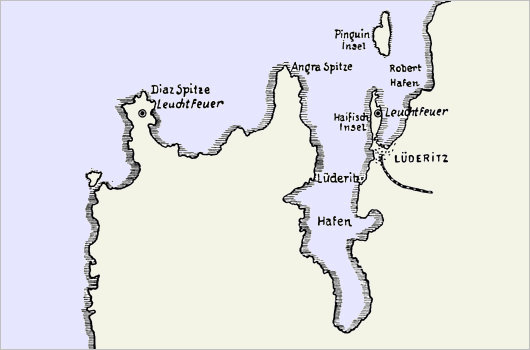
You drive to the end of the world, turn left, and continue. That’s the way to get to Diaz Point. Namibia’s coastline is supposed to be the least hospitable on the planet, with desert meeting salty ocean with naught in between. Staying the night at Seeheim, an agglomeration of half a dozen houses nearby a stone castle hotel, we woke early and drove the 200+ miles west through the arid rocky desert. The experience is made all the more interesting for the 16,000-square-mile “Restricted Diamond Zone” one drives on the northern periphery of. Namibia’s diamonds are primarily alluvial deposits, meaning they rest on ancient river beds, sitting on the soil or resting just a few feet below. The forbidden territory’s guards are believed to have a policy of shooting first and asking questions later. There are over sixty countries in the world smaller than the Sperregebiet (forbidden area), as the Restricted Diamond Zone is colloquially known.
Eventually — passing through the area inhabited by the wild horses of the Namib, descendants of German cavalry horses and farm animals variously escaped or set free — you arrive at the town of Lüderitz on the Atlantic coast. Besides its German street names (Zeppelinstraße, not to mention Bismarck, Bahnhof, Moltke), the town’s architecture is a curious Teutonic colonial, reinvented for the almost-tropical locale. From one or two of the local businesses, one could easily imagine a slightly overweight German in a linen suit and panama hat, with an eye-patch as well as a cane for his limp, ordering around the natives crudely while engaged in some nefarious criminal enterprise or campaign of sabotage.
But for Diaz Point, you go to Lüderitz, turn left, and go further still. Driving south from the colonial town, you encounter a barren, rocky, and utterly colourless landscape, the grey tones of which immediately bring to mind the surface of the Moon. Am I still on Earth? Only the blue sky and the occasional appearance of vegetation remind you that you’re still on the third planet from the Sun. (more…)
The State Opening of Parliament
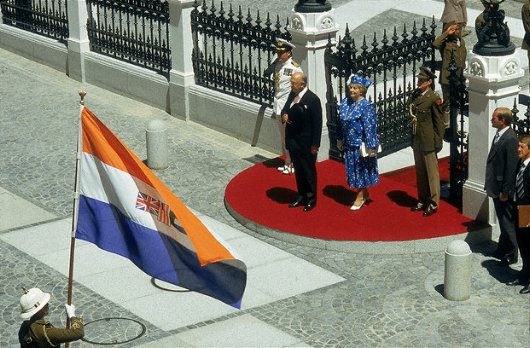
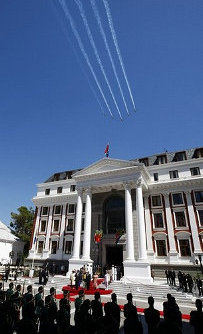 The State Opening of Parliament has always been an occasion of great ceremony, most especially so on the one occasion when the King of South Africa himself was actually present. When South Africa became a republic in 1961, the State President took the role of the Governor-General. While formerly centered on the old main entrance, the President now enters Parliament at the 1983 wing (as seen at right), where he is greeted by a guard of honour and pauses to hear the National Anthem played by a military band.
The State Opening of Parliament has always been an occasion of great ceremony, most especially so on the one occasion when the King of South Africa himself was actually present. When South Africa became a republic in 1961, the State President took the role of the Governor-General. While formerly centered on the old main entrance, the President now enters Parliament at the 1983 wing (as seen at right), where he is greeted by a guard of honour and pauses to hear the National Anthem played by a military band.
Before 1994, morning dress was the norm for the State President (and for the Governor-General before him), but since that time the head of state has tended to wear a business suit on the occasion. That doesn’t stop the other Members of Parliament and their spouses from dressing up. There’s an unspoken contest among female MPs and MPs’ wives to wear the most daring or arresting hat to the State Opening, and often tribal leaders attend in the traditional dress of their peoples. (more…)
Hollandic Heraldry
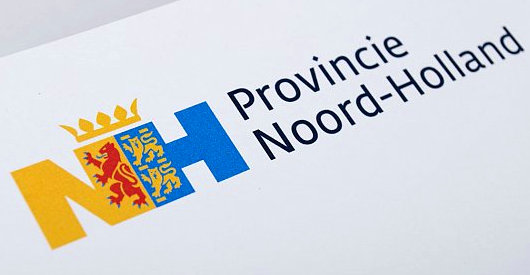
The Eden Spiekermann group, who were responsible for the redesign of The Economist in 2001, recently developed this logotype for the Dutch province of North Holland. The conjoined legs of the ‘N’ and ‘H’ integrate the province’s coat of arms.
The Abolition of Humour
Police Inspector Blog, by “Inspector Gadget”, is a pseudonymous blog written by a police officer that documents the absolute ridiculousness of modern British policing. The inspector has also published a book documenting how “you can be arrested for pinching a few crisps from a schoolfriend, throwing cream cakes or denying the existence of Santa Claus – while burglars, muggers and drug dealers go about their business unmolested by the forces of law and order”. I’ve been reading the blog for years now and it definitely lives up to its tag phrase of “You couldn’t make it up!”
Gadget’s latest post shows how humour has been systematically abolished in the modern police services:
Humour is almost exclusively at someone else’s expense, and in todays modern police service, we cannot mock anything or anyone, even if they can’t hear us, without being labelled as an “ist” of some kind. The public can ridicule the police as much as they like of course.
So, eight beautiful girls on a hen night, two men with funny hats, a uni-cyclist(???) and three lads dressed as penguins all walk past without even a comment or a snigger from the F Division Public Order team.
One night, an absolutely stunning woman approached the van and pulled aside her blouse to show us her naked chest. This happens a lot in Ruraltown, and in every big town. Hen night ladies are notorious for it. Imagine her shame when we simply stared at her, unmoved and silent.
“What the hell is wrong with you lads? You havent seen better than this have you?”
What was I supposed to say?
“I’m sorry madam but your outdated and sexist humour is not appreciated here; we are modern policemen you know, now move on and show your flesh no more.”
Shamelessly using the anonymity of this Blog, I feel that I can finally answer the lady in question. And my answer is this, No, we have not seen better than that. I thank you.
Via Hilary.
A little dilapidation goes a long way
Chelsea, Muttontown, L.I.
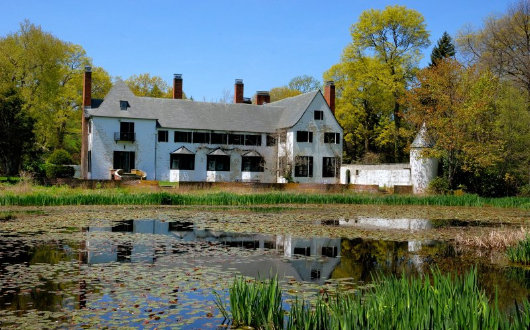
I have commented before about the perils of over-restoration, in which a building’s owner becomes a little too enthusiastic about its preservation and ends up with a building that, except in style, looks almost new. Chelsea sits on a 500-acre preserve in Muttontown, L.I. which has come into the hands of the government of Nassau (the county on Long Island in-between Queens County and Suffolk). The county has managed to maintain the house and its grounds at exactly the appropriate level: not plastering over every crack to make it ‘good-as-new’, nor neglecting it so it becomes structurally unsound, but rather allowing it to develop and age naturally. These photographs from the ever-capable James Robertson admirably display the house and its grounds, including its shallow canal-moat. (more…)
The National Assembly
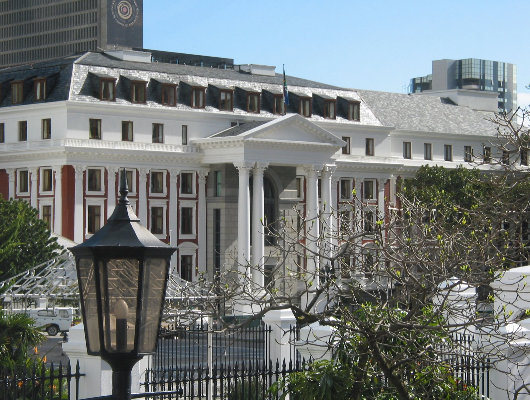
Despite the longer history behind the original wing of South Africa’s Parliament House, when most people think of Parliament today they think of the 1983 wing that currently houses the National Assembly. The wing was designed by the architects Jack van der Lecq and Hannes Meiring in a Cape neo-classical style similar to the rest of the building, and it is actually quite a handsome composition despite the awkwardly proportioned portico, which is too tall for its width or two narrow for its height. (more…)
Brothers Aboard the Ship of State
The Viscount Philippe de Villiers is an MEP, sometime French presidential candidate, and head of the Mouvement pour la France but his brother, General Pierre de Villiers, has just been named personal Chief of Staff to the President of the Republic (whose name we refrain from mentioning, lest we feel compelled to boo and hiss). Given this recent appointment, we reckon that General de Villiers outranks his brother in the grand apparatus of state; Chef d’etat-major particulier beats President of the General Council of the Vendée.
There is, however, at least one regard in which the civilian has his military brother beat: Pierre only has six children, Philippe has seven.
Rouwkoop: An Old Cape Hodgepodge
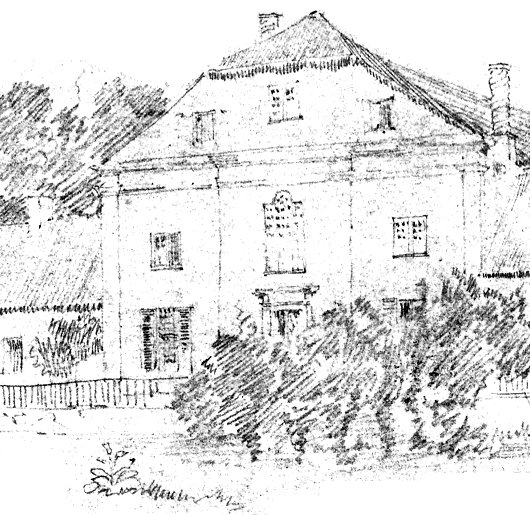
We can deduce a lot about a power by looking at the structures it erects. The return to neo-classicism under Stalin after the earlier Russian deconstructivist architecture of the 1920s is telling, as is the almost universal (and only seemingly contradictory) adoption of socialist Bauhaus architecture for the headquarters of New York corporations in the post-war period, or the turn to Brutalism by the governments of numerous Western liberal countries in the 1960s, 70s, and 80s. While the apartheid government adopted a guise of conservatism, its revolutionary re-ordering of South African society was so radical that, for example, the old Edwardian railway station in Cape Town was demolished and completely rebuilt in order to better accommodate the separation of the races.
When the Afrikaner Nationalist government was elected in 1948, it inherited one of the richest architectural traditions in the world. South African architecture, from the original Cape Dutch so praised by Ruskin, through the Cape Classical of the architect Thibault and the sculptor Anreith, and on to the attempt at a South African national style by Edwardian architects like Herbert Baker, the nation’s legacy of boukuns (building-art) is one of which any nation would be proud.
The Cape Dutch style has proved particularly versatile and easily reinterpreted in almost every age of South African history since Jan van Riebeeck planted the oranje-blanje-blou on these shores in 1652. Yet from 1948 until its final electoral demise in 1994 the National Party government erected almost no buildings in the “national style” of Cape Dutch or its aesthetic descendants. Instead, they built in the grim modernist style found everywhere else in the world, both in the liberal-capitalist West and the totalitarian-Marxist East. One need only consider the Nico Malan (now Artscape) in Cape Town, the Staatsteater in Pretoria, or the Theo van Wijk building at Unisa. (more…)
’n Indiese woning in die Moederstad
Kaapstad het ’n bietjie van die Himalajas
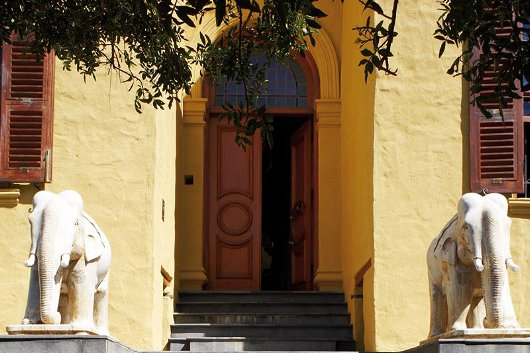
Twee versamelaars van suid-Asiatiese kuns het ’n subkontinentale woning in ’n Kaapstadse meenthuis geskep. Die huis was die onderwerp van ’n artikel deur Johan van Zyl in ’n onlangse uitgawe van Visi-tydskrif met hierdie foto’s van Mark Williams. Die algehele effek is ’n bietjie “over the top” vir my, maar die verleiding van die Oriënt sal nooit ophou. (Bo: ’n Paar van marmer-olifante uit Udaipur wagte by die hoofingang).
“In ’n nou keisteenstraat aan die rand van die Kaapse middestad staan ’n huis met ‘n geskiedenis” Mnr van Zyl skryf. “Toe dit in 1830 vir Britse soldate gebou is, het die branders nog digby die voordeur geklots, en nie lank daarna nie het Lady Anne Barnard hier sit en peusel aan ’n geilsoet vy wat ’n slaaf vir haar gepluk het, stellig van dieselfde boom wat nou in die huis se (nuwe) trippelvolume-glashart staan, ’n knewel met ’n vol lewe agter die blad.”
“’n Dekade of twee gelede het die reeds luisterryke geskiedenis van die huis ’n eksotiese dimensie bygekry toe twee toegewyde versamelaars — selferkende stadsjapies wat destyds in die modebedryf werksaam was — hier kom nesskop met hulle groeiende versameling Indiese oudhede.” (more…)
An Evening at the Travellers Club
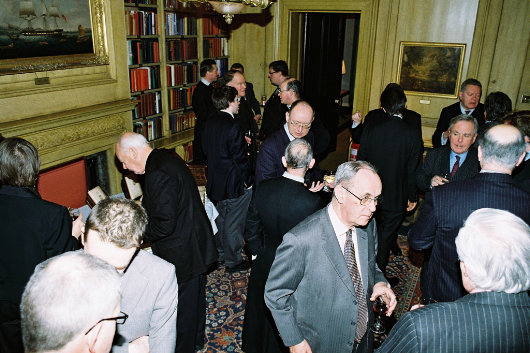
Photo: © Zygmunt von Sikorski-Mazur
TO CLUBLAND, THEN, for a book launch. Of course the secret about book launches is that they are often enough a convenient excuse to assemble a whole troop of interesting characters together, with the introduction of a newly published volume occupying a secondary (while nonetheless prominent) role. In this, our esteemed hosts Stephen Klimczuk and Gerald Warner of Craigenmaddie, authors of Secret Places, Hidden Sanctuaries, exceeded themselves. For me, the evening actually began not in the Travellers but just around the corner in the Carlton Club. Rafe Heydel Mankoo had suggested meeting up there for a drink or two or three before proceeding thencefrom toward the book launch at the Travellers. Pottering over from Victoria, I arrived at the Carlton and was guided towards the members’ bar where I easily found Rafe nursing a drink beside the hearth.
The usual updates were exchanged of various goings-on that had taken place since our last combination in August. Conversation naturally turned to Canada (where Rafe was raised) and shifted to New Zealand just before we greeted the arrival of Guy Stair Sainty. Guy I first met just four years ago while enjoying a pilgrimage to Rome. We happened to stumble upon him in the Piazza San Pietro (as one does with an odd frequency in the Eternal City), and, as it was my birthday, we invited him to join us for some champagne at this little place that overlooks the square. Guy was then in the midst of completing for Burke’s Peerage the massive, two-volume World Orders of Knighthood & Merit, or “WOKM”, which loomed restively on a nearby table as we sipped our drinks in the Morning Room. (more…)
Government Buildings, Dublin
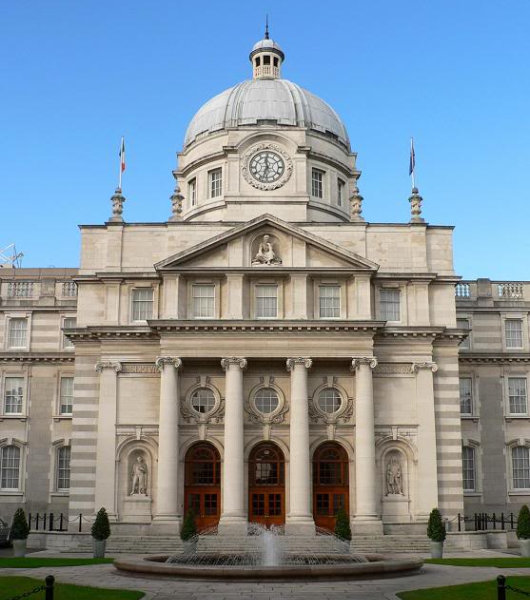
Image: GrahamH
On Upper Merrion Street at the end of Fitzwilliam Lane in Dublin sits a thoroughly Edwardian pile which has been given the thoroughly boring title of ‘Government Buildings’. The city ceased to be a legislative capital in 1800 when the Irish Parliament voted to abolish itself and join the United Kingdom, so government edifices constructed during the nineteenth century lacked the proud stateliness of the Grattan era. The Westminster parliament finally conceded the principle of Irish home rule in 1914 but disastrously suspended its implementation due to the First World War. In stepped the Irish Volunteers, Easter 1916, the IRB, and all that and by the time the Treaty of Versailles ended the conflict on the continent, Britain was up to her neck in troubles in Ireland. Events had intervened and the unimplemented concession of home rule proved insufficient to quell the dire situation.
Even so, the Government of Ireland Act 1920 partitioned the island and created a separate government for ‘Southern Ireland’ and ‘Northern Ireland’, each with its own devolved legislature. The old Irish Parliament House had been sold to the Bank of Ireland so there was a question as to where the two houses of the new Southern Irish body would convene. Eventually the government decided upon this building, the Royal College of Science, and it was commandeered for that purpose. (more…)
A Wander Through the V&A
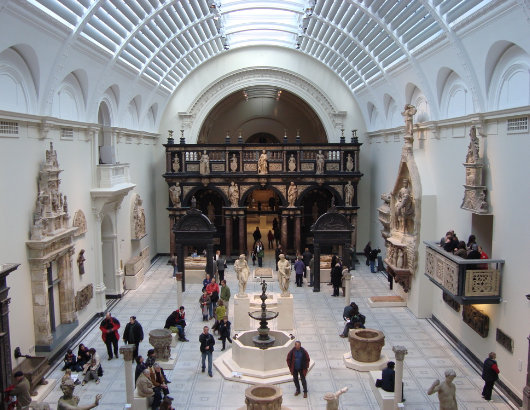
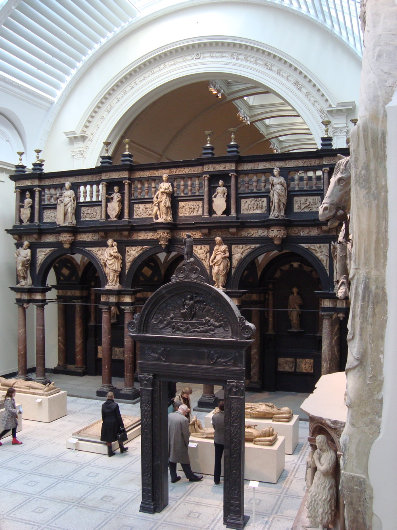 When on earth was the last time I was in the V&A? To be honest, I’ve no idea, though I’m certain my first visit was (like that of many others) as a wee one, the summer after kindergarten to be precise. It’s a stonking great place with tons of stuff in it, and one of the startling few that deal with architecture as a subject in its own right. (A fact which wins admiration in the heart of this architecture fan).
When on earth was the last time I was in the V&A? To be honest, I’ve no idea, though I’m certain my first visit was (like that of many others) as a wee one, the summer after kindergarten to be precise. It’s a stonking great place with tons of stuff in it, and one of the startling few that deal with architecture as a subject in its own right. (A fact which wins admiration in the heart of this architecture fan).
Of course the Victoria & Albert Museum has been fresh in the minds of many most recently for the re-opening of its Medieval & Renaissance sculpture galleries. The new arrangement cost over £30 million, took seven years to complete, and includes ten new display rooms displaying, as the Guardian put it, “a world of ravishing luxury”. So it seemed silly not to have a little wander round the South Ken institution yesterday, especially since it was a rainy afternoon. (more…)
Kidnap and Rescue
Followers of Seraphic’s blog will doubtless have read of my Caledonian misadventure, whereby I was kidnapped by the inhabitants of an historic house in East Lothian. This update was followed by the Sexagesima Social Report, detailing our Sunday Mass, followed by the Cup of Tea of Peace, followed by the Gin & Tonic of Fortitude. Pleasant as my enforced captivity was, various duties in London obliged me to cooperate with the successful rescue effort made, curiously, by Royal Dutch Commandos.
Further ruminations on my Britannic sojourn are forthcoming.
The Dovecot at Alphen (1989)
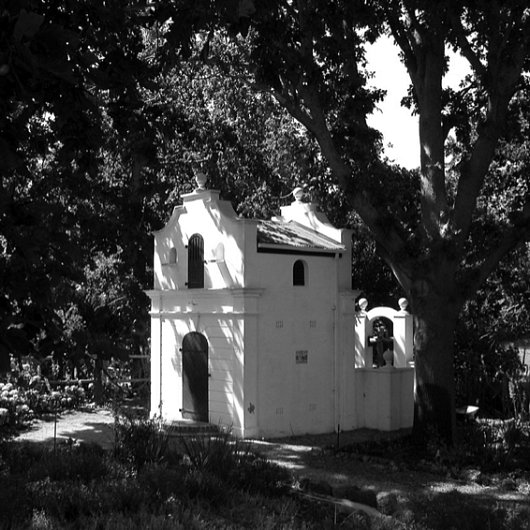
ESTABLISHED in 1714, Alphen is one of the legendary estates of the Cape Peninsula: Dr. James Barry duelled on the south terrace with Josias Cloete, and its guests include the illustrious names of Mark Twain, Cecil Rhodes, Field Marshal Smuts, and many more. While it once covered most of northern Constantia, the estate was much reduced during the twentieth century (and the M3 Simon van der Stel Freeway was built through its vineyards), Alphen, now a country-house hotel, is growing once again in the hands of the latest generation of Cloetes.
In 1989, the council authorities visited Alphen and declared that an electric substation must be built on the site or the hotel be forced to close. The ancient electric supply lines had, it turned out, been constructed illegally, and there was some danger of fire unless a substation was built on the Alphen property itself.
“Horrified we said there must be some other way,” writes Nicky Cloete-Hopkins (in the Journal of the Vernacular Architecture Society of South Africa). “There wasn’t, and Dudley [Cloete-Hopkins] said to Dirk [Visser, architect], who had been working with us for about five years by that time, ‘Disguise it as a folly or something.’”
“The ideal site for ours was … on the banks of the Diep River, at the end of a path leading from the 1772 water mill. It was in line with the strict grid pattern of the farm complex and gardens, much of which had been destroyed in the early and mid part of the twentieth century. We briefed Dirk to have fun, create a ‘folly’ and incorporate the Mitford-Barberton crucifix and family plaques from a Garden of Remembrance, demolished after the farm was subdivided.” Ella Lou O’Meara was later commissioned to do a family tree in tile for the Garden wall.
“Dirk suggested the dovecote — although we have had difficulty in keeping doves there. A little flamboyance has often enhanced the severity of the architecture at Alphen, and Dirk’s sketches for the proposed dovecote delighted us.”
Alphen and its great square of farm buildings had been designated a National Monument — akin to landmarking in the U.S. or listing a building in Britain — and so changes or additions needed to meet with the approval of certain historic advisors. “The builders had nearly completed their work when the then National Monuments Council sent representatives to inspect it. They commented that the design was not ‘honest’ and that we were fooling the public in making it look like a historic building.”
Mrs. Cloete-Hopkins wondered if the NMC wanted them to build something horrifically functional in the middle of a historic site for the sake of “honesty” or whether they wanted them to “erect something ultra-modern” like the new Louvre pyramid that was causing controversy at the time. “In any event it was too late to look at alternatives and I happily satisfied requirements by putting the date and the name of the architect and builder on the side of the building.”
A wise compromise and, like the dovecot/substation itself, informed by precedent.
An Old Dutch Holdout
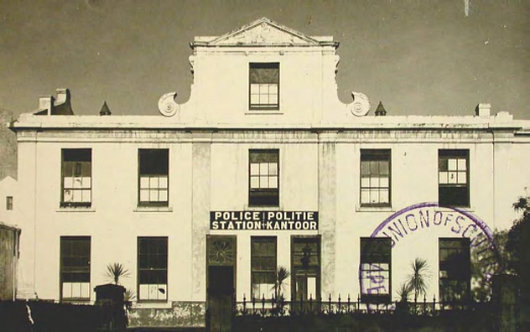
The sign on the façade of No. 7 Wale Street, Cape Town in this 1891 photo informs us of its status as a police station in the two official languages of the day, English and Dutch, not Afrikaans. ‘Politie’ is the Dutch word for Police, while the Afrikaans is ‘Polisie’. Afrikaans only became an official language of South Africa in 1925, but was so alongside Dutch and English until 1961, when Dutch was finally dropped.
This beautiful old Dutch townhouse, with its typical dak-kamer atop, didn’t survive as late as 1961. The Provinsiale-gebou, home to the Western Cape Provincial Parliament, was built on the site in the 1930s. Those who viewed the 2009 AMC/ITV reinterpretation of “The Prisoner” might remember an outdoors nighttime city scene after the main character leaves a diner, with the street sign proclaiming “Madison Ave.” and plenty of yellow New York taxicabs streaming past. The large arches in the background are the front of the Provinsiale-gebou.
Search
Instagram: @andcusack
Click here for my Instagram photos.Most Recent Posts
- Amsterdam November 26, 2024
- Silver Jubilee November 21, 2024
- Articles of Note: 11 November 2024 November 11, 2024
- Why do you read? November 5, 2024
- India November 4, 2024
Most Recent Comments
- on The Catholic Apostolic Church, Edinburgh
- on Articles of Note: 11 November 2024
- on Articles of Note: 11 November 2024
- on Why do you read?
- on Why do you read?
- on University Nicknames in South Africa
- on The Situation at St Andrews
- on An Aldermanian Skyscraper
- on Equality
- on Rough Notes of Kinderhook
Book Wishlist
Monthly Archives
Categories


